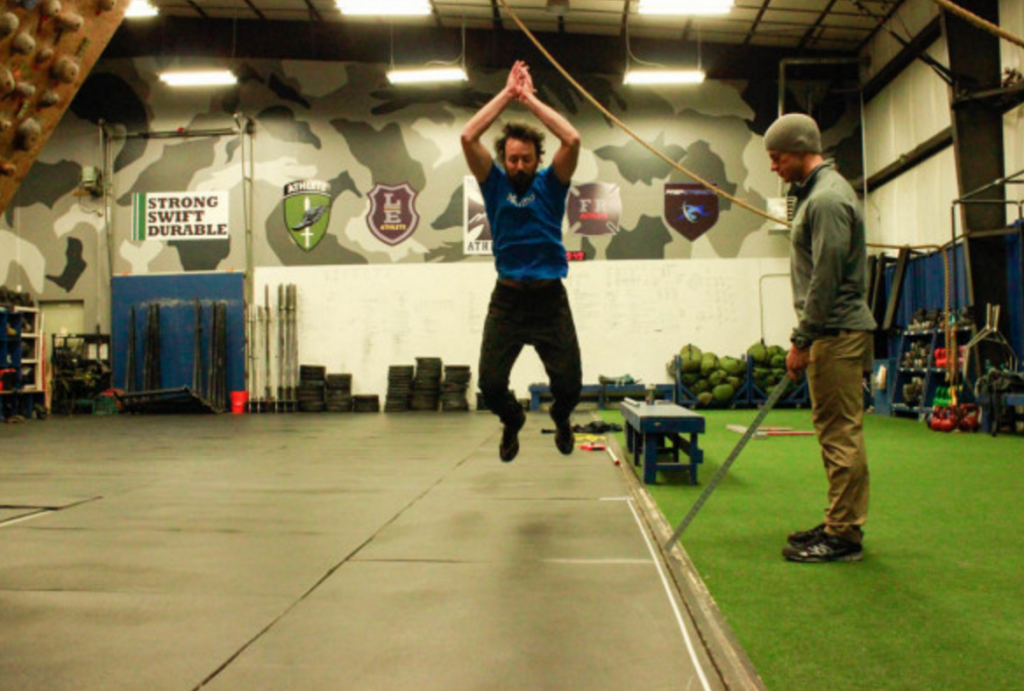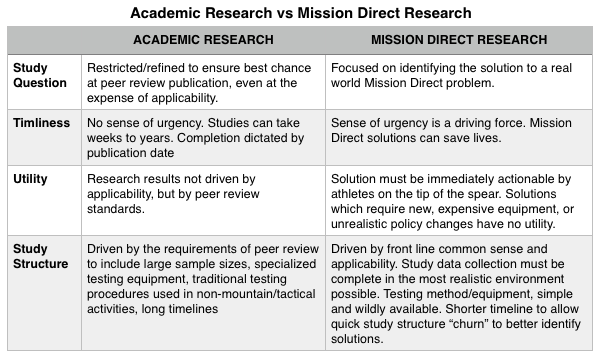
By Rob Shaul and Adam Scott
Our driving purpose at the Mountain Tactical Institute is: “To improve mountain and tactical athletes’ mission performance, and keep them safe.”
Central to this purpose is the focused intention of being “mission direct” in everything that we do – daily training sessions, training plans, articles, research, etc.
“Mission Direct” means instantaneously improving performance by putting actionable solutions directly into the hands of those at the tip of the spear.

Research is how we test and identify these actionable solutions. However, as we’ve worked to complete research studies, it’s become clear the traditional academic research process is a poor fit to identify Mission Direct solutions.
At the 10,000 foot level, the goals of academic and Mission Direct research differ.
The goal of academic research is to get the study published in a peer-reviewed Journal. This is a professional requirement for academics and graduate students, and often a measure of their competency.
The goal of Mission Direct research isn’t publication. The goal is to quickly identify actionable solutions to improve mountain and tactical athletes’ mission performance.
And, as we’ve dug into individual studies, this disconnect has identified practical differences between the two approaches:


THE DANGER OF SLOPPY RESEARCH
We understand and own the possibility that our Mission Direct Research methodology may be criticized for resulting in sloppy research. Realistic, mission-applicable data collection environments are simply not as controllable as unrealistic, but very controlled, lab settings common in academic research.
As well, the sense of urgency underneath our research produces timelines which challenge convention.
In the short run, we make the conscious trade for a “good solution now” over a “perfect” solution, much later.
In the long run, we hope via the crowdsourcing process – both scrutiny by front-line mountain and tactical athletes, and repeat studies via our coming Research Wolf, will narrow this difference, and result in more “perfect” solutions, quicker and quicker.
In this sense, the goal of Mission Direct Research is not to get to the perfect solution the first time, but rather get faster and faster at “churning” the study methodology and feedback loop after the first attempt to produce the best solution faster.
This is happing already. One of the advantages of rapidly churning studies, short study iterations, and conducting multiple studies concurrently is we are quickly getting lots of Mission-Direct study experience. We’re learning from our mistakes, and applying these lessons to the initial study design for new studies. By making the first iteration better out of the gate, the trip to the best solution comes faster.
Strict academic research methodology is not perfect. Many peer-reviewed, published academic studies have been later debunked for poor study structure, unrealistic data collection or misleading statistical analysis.
As well, many well done academic studies have to be so restricted to meet strict peer review standards their study questions become so narrow as to be unrealistic, and study findings are not deployable in the real world. For academics, this works as the goal of the academic research is publication, not finding solutions.
RESEARCH WOLF
The most exciting aspect of Mission-Direct research is an invitation to front-line mountain/tactical athletes, coaches, instructors and practitioners to get involved with the process.
Right now we are open to and encourage study ideas. As researchers, we simply are not in the position to identify and understand fully the most pressing mission-direct problems facing our athletes. We need your help.
Indeed several of the studies we are currently working on have come from problems identified by those who follow and use our work.
Coming soon we will be crowdsourcing and democratizing the research via our Research Wolf platform.
Ultimately, Research Wolf will serve two roles. Mountain/Tactical athletes, coaches, instructors, and educators anywhere will be able to piggyback on a study we’ve completed or are completing as lab rats themselves. More study subjects will either further prove our initial findings, or quickly identify issues and problems with the research we can go back and address. Because the ultimate goal is Mission-Direct solutions, not publication, all that matters is outside performance. We’ll gladly update and publish findings as more data comes in. In this way, we hope to apply some of the powerful effects of big data to our Mission Direct research method.
Second, we want Research Wolf to become a platform anyone can use to conduct their own studies. Research Wolf will democratize research. The platform will allow the user to establish a study question, coach them on how to set up study and control groups, structure the data collection, input the results, conduct the statistical analysis, and interpret the conclusions. By crowdsourcing research in this way, we hope Research Wolf becomes not only a source of continuing study results and data collection but also an exciting place for us to identify the study issues most affecting mountain and tactical athletes.
We imagine a day soon where a squad leader at a line military unit, curious about the best way to improve his squad’s marksmanship, will use the Research Wolf and his squad-mates as lab rats, to design a study and test two marksmanship instruction methodologies, and identify the one which works best. He will share the results with his platoon, enlist them to re-test the study, confirm the results, and take the findings up the chain all the way to the brigade commander, who impressed with the results and the Mission Direct research methodology, will implement the instruction, resulting in the entire brigade improving marksmanship.
Seeing the results we would share them with the community, spreading the knowledge quickly across multiple brigades and services.
Now imagine dozens of squad leaders, platoon first sergeants, platoon commanders, company commanders and on and on conducting and churning and sharing their own research results across broad swaths of fitness, training, equipment, and policy. The compounding effect could be incredible!
Below we break down the steps in a traditional scientific method, and how these are applied in both traditional academic research and our Mission Direct Research. Following is a flowchart we’ve created to help us understand the process.
We’d appreciate your input, questions, and feedback. Please email rob@mtntactical.com.


Learn more about MTI and our promise that Our Stuff Works. Guaranteed.
